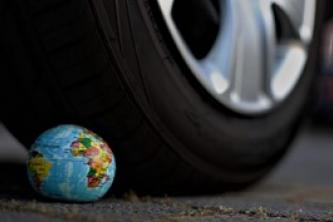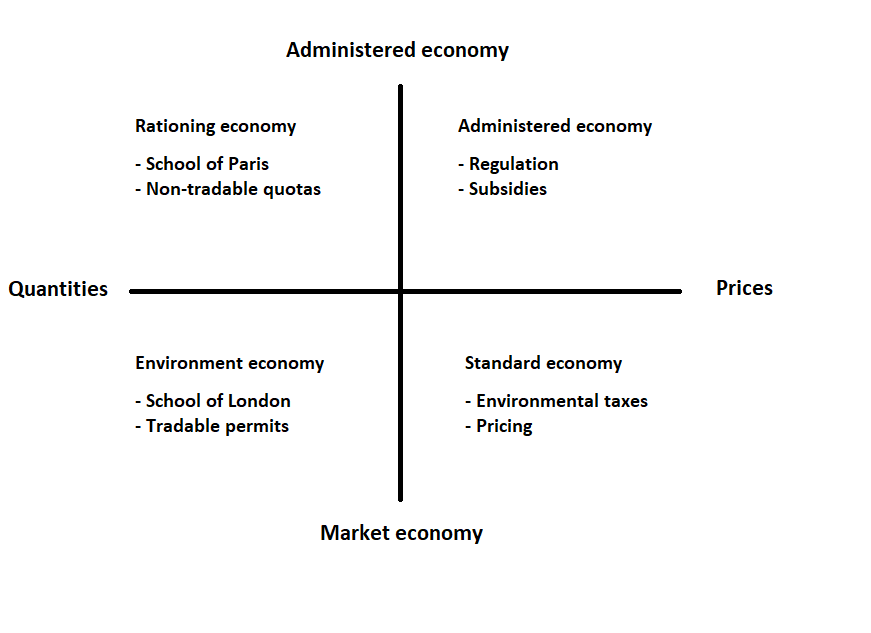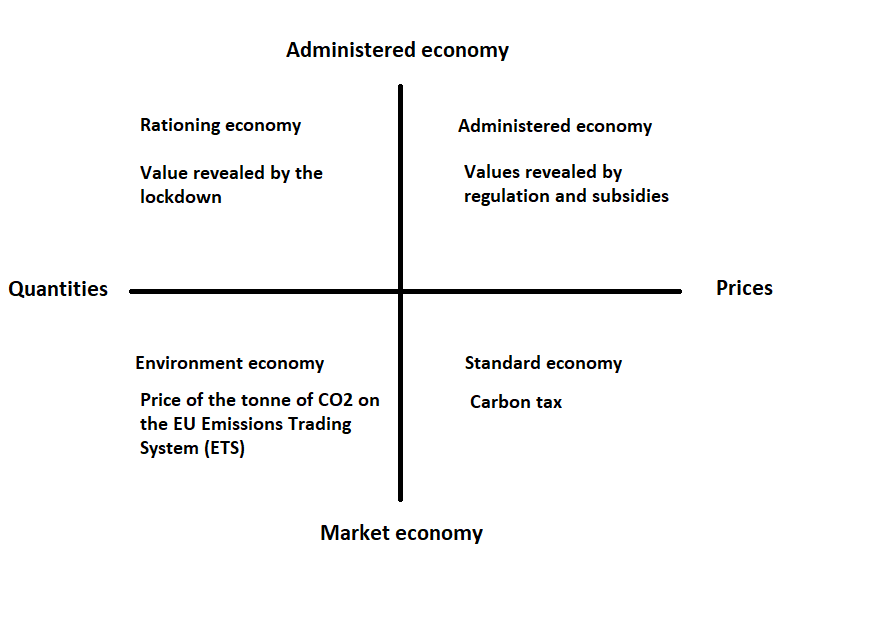
5 september 2022
Reducing greenhouse gas emissions (GHGs) - especially carbon dioxide (C02) - has become a pressing matter for public policies. Different tools are available to pursue it, such as regulations and subsidies. But how should the “price of carbon” be determined and then integrated into the economic decisions of private and public actors? What do current economic policies tell us? And how could quantity regulation become an essential tool alongside pricing measures?
The European Union (EU) aims to reduce GHG emissions by 55% by 2030 compared to 1990 levels, by mobilising different levers such as regulation and subsidies. But insofar as we live in market economies, prices should also reflect the costs that GHG emissions impose on the community. How then should we determine the “price of carbon 1 ” and integrate this into the economic decisions of private and public actors?
To answer these questions, we will begin by re-examining the “polluter pays” principle, presenting its main tenants but also its limits, which led the Quinet Commission to change its terminology: while its first report (2009) 2 spoke of "the tutelary value of carbon," the second, published in 2019 3 , refers to "the value of climate action.” This will lead us to the second part, explaining why quantity regulation is often preferred to price regulation, particularly in the field of transport. The question remains as to whether the same will apply to GHGs.
For over a century 4 economists have shown that market prices are not the best for the community when they only consider private costs while ignoring social costs, which include negative externalities such as pollution or noise. Public policies should therefore make polluters bear these costs. But it is not easy to place a monetary value on externalities.
In economics, an externality occurs when the activity (production or consumption) by an economic agent (individual or company) has an impact on the well-being of a third party, without this interaction being subject to a payment in the case of a positive external effect (called "external benefit" or "positive externality") or compensation in the case of a negative external effect (called "external cost" or "negative externality"). Transport-related pollution is an example of an external cost. The internalisation of negative externalities consists of creating mechanisms to integrate these costs into the economic decisions of public and private actors.
But how should we calculate the level of these costs to be internalised, in particular those related to CO2 emissions?
How far are we willing to go to reduce GHG emissions? What will be the trade-off between damage costs and abatement costs and what form will this take? As we will see, this will not only involve taxation and setting the price of carbon: internalisation can take several forms.
To internalise the external costs – to make those who are responsible pay - there are 4 standard solutions.
We can see here that on top of using different methods, these four options correspond to ideological divides. The different ways of combining price-quantity pairs on the one hand, and administered vs market economy on the other, are based on different schools of thought (Figure 1). For the time being, public policies combine three types of instruments: regulation, taxation and tradable permits, which are linked to the London School 6 .

Figure 1: The toolbox for internalisation: ideological divides
But faced with increasing climate change, some consider that we are now at war with GHG emissions and that, as the ends justify the means, we must do what is necessary "whatever the cost." Degrowth may then be the only solution to reconcile the economy with life 7 . With the advent of "ecological planning," will public decision-makers in France add the concept of rationing in its various forms to their toolbox?
We can try to assess the cost of one tonne of carbon, revealed by these different action models aimed at limiting the negative externalities linked to greenhouse gas emissions, and compare it with the recommendations of the Quinet report on the price of a tonne of carbon in France. In its second report, the Quinet Commission calls for regularly increasing the official value of a tonne of CO2: €54 in 2018, €87 in 2020, €250 in 2030 and €750 in 2050. But this recommendation is not being implemented: the values of climate action differ from one form of internalisation to another. Can ecological planning help regain some coherence?
The recommended price of carbon by the Quinet Commission is known as a tutelary value, an “official” price that is supposed to be imposed on everyone. But that is easier said than done. Indeed, an examination of public and private choices reveals highly variable values of climate action, whether explicit or implicit. Figure 2 presents, as an extension of Figure 1, examples of each school of thought and reveals various carbon values.

Figure 2: Schools of thought and examples of revealed values of one tonne of C02
We will expand upon the content of each quadrant, starting at the top right, relating to an administered economy (regulation and subsidy) and then going clockwise.
This quick overview shows that the situation is not optimal. The explicit price of CO2 remains zero or low for most private actors (bottom half of Figure 2). The situation is different for the public sector (top half of Figure 2), the budgets of which also have to support subsidies that remain moderately effective 10 . To achieve a more tangible reduction in GHG emissions, the value of climate action needs to increase for private actors.
The sharp decline in GHG emissions in 2020 has been transitory. In 2021, road transport emissions increased by 6% in France. They remain at a slightly higher level than in 1990. The slight downward trend that began in the last twenty years (barely 1% per year) means that transport emissions represent 29% of total emissions in France in 2020, compared to 23% in 1990. For this reason, the National Low Carbon Strategy (SNBC, Stratégie nationale bas carbone) is now banking on an annual reduction of 3%. Yet, to achieve this goal and maintain some credibility, public policies cannot simply revolve around handing out subsidies. They must involve private actors more clearly. How can we do this when growing inflation keeps the issue of purchasing power at the heart of the public debate?
No one has forgotten that in 2018, an increase in the "climate-energy contribution" – the carbon tax on fuels – sparked the Yellow Vests movement. More recently, the sharp rise in gas, electricity and fuel prices has led most governments to reduce energy taxes. How could they now announce the introduction or increase of a carbon tax? This paralysis is not only cyclical: it is the result of the fact that households and businesses already pay very high taxes on road fuels. By considering the TICPE (Domestic tax on consumption of energy products) as an effective carbon tax, B. Dequiedt 11 calculated that diesel car owners already pay the equivalent of €250 per tonne of CO2. Heavy goods vehicles, which benefit from a partial reimbursement of TICPE, pay €180. Meanwhile, air transport and maritime transport is charged practically nothing.
Such figures first of all reveal an urgent need to introduce a carbon tax where one does not already exist. But they also invite us to question the limits of taxation through the notion of price elasticity. Economists use it to designate the ways in which volumes of consumption vary when prices change. However, this price elasticity is relatively low, as shown, for instance, by road fuel deliveries in April 2022. While the price of a litre of diesel was close to €2 - which was 33% more than in 2019 - the quantities sold fell by only 8% compared to April 2019. This low responsiveness of demand stems from the fact that many car trips are necessary and unavoidable. For most workers, getting to work without their car is very difficult. Because of poor public transport options in peri-urban and rural areas, where the longest daily commutes take place, changing travel modes is very costly in terms of travel time. The same applies to carpooling because people living in the same area do not have schedules and destinations that easily align. This is why public policies are focusing more on the electrification of cars to reduce emissions, although such a strategy will take time due to the increasing lifespan of cars (over 18 years). In Norway, in 2020, combustion engine vehicles accounted for only 17% of registrations, but electric vehicles represented only 20% of all cars in circulation 12 , which is what France hopes to achieve by 2030!
These findings show that taxation is essential but on its own it is insuficient, and this applies to tradable quotas 13 , because even when there is a carbon tax or a market for tradable permits, the revealed prices of tonnes of CO2 remain insufficient to significantly reduce emissions. Indeed, to ensure acceptability, public policy makers cannot increase this price disproportionately.
Although not explicitly stated, the limitations of price regulation explain the unexpected success in France of the term "ecological planning." During the electoral campaigns of spring 2022, the term was used both by the political parties on the left (NUPES, The New Popular, Ecological and Social Union) and by the President of the Republic, before and after his re-election. But this expression simultaneously refers to different worlds.
The main lesson of this overview is that the price of carbon and the value of climate action can be measured in euros via the notion of damage cost or abatement cost. It is actually a necessary step to make private actors responsible, so that the cost of the transition does not rest solely on public budgets and, therefore, on deficits. In this view, it is imperative that the price of carbon, and therefore of fossil fuels, increases tendentially faster than inflation. This seems impossible in the short term, at a time when there are more and more tax reductions on oil, gas or electricity 18 in Europe. However, it is clearly needed if we want to take climate commitments seriously. Public subsidies to support the transition to electric vehicles or the insulation of houses are necessary, but insufficient if they are not also accompanied, in the medium and long term, by an increase in the relative prices of carbon-based energies.
Just like subsidies, pricing measures are necessary but insufficient. Acting on quantities must also be considered. Its most restrictive form, and probably the most difficult to accept, would be some form of rationing, carbon quotas or limiting the right to travel by plane, for example. But there are also more progressive forms that invite us to question what a change in mobility practices and more generally in lifestyles could cost in various forms. This could involve, for part of the population at least, the relocalisation of activities that are currently spatially dispersed, increased travel times due to the use of slower 19 and less carbon-emitting modes, reduced activity programs, etc. Even if this type of action is less intrusive than quotas, it is also challenging in terms of acceptability because it contradicts the "always more" mindset underpinning the implicit social contract that has prevailed for decades in terms of mobility. At the heart of this system lies the idea of a continuous increase in purchasing power and thus in the value of time, which encourages people to increase travel speeds and the number of places and activities that can be accessed in a given time. The modest results obtained by industrialised countries in reducing GHG emissions show that we still have not abandoned this "always more" mindset. If, to paraphrase Nietzsche, the value of climate action lies in what one is willing to do to reduce GHG emissions, then it is clear that this value remains quite low today. We are not ready to pay a high price to reduce carbon emissions.
1 There is a close relationship between carbon and CO2. 1kg of CO2 corresponds to 0.2727 kg of carbon. If a tonne of CO2 is worth €25, a tonne of carbon is worth €91.68 (25/0.2727). In English, the price of carbon is equivalent to the price of CO2.
4 The founding works of A.C. Pigou are from 1920
5 PPM = parts per million. A value of 550 ppm of CO2 in the atmosphere means that one liter of air contains an average of 0.55 ml of carbon dioxide. Currently the average rate in the Earth's atmosphere is 415 ppm; it was less than 300 before the industrial era and could quickly reach 450 ppm. As the concentration of CO2 rises, the climate keeps getting warmer.
6 The economist David Pearce (University College London), with his colleagues, published what is considered a seminal report for environmental economics. PEARCE D., MARKANDYA A., BARBIER E., 1989, Blueprint for a Green Economy, London, Earthscan
7 René Passet, 1979, L'économique et le vivant [The Economy and the Living], Payot, Paris, 287p. The work of René Passet, professor at the Sorbonne, has become so important that it warrants speaking of a "School of Paris." He was the first President of ATTAC’s Scientific Board.
8 CGDD, Trajectoire de transition carbone au moins coût [Carbon transition path at the lowest cost], Théma, 2016, page 54. See also the CGDD’s work in September 2021: https://www.ecologie.gouv.fr/sites/default/files/thema_analyse_09_prime_conversion_vehicules_particuliers_en_2019_septembre2021.pdf
9 Fridstrom L. 2021, The Norwegian Vehicle Electrification Policy and its implicit price of Carbon, Sustainability, 13, 1346
10 From 2012 to 2018, total road transport emissions fell by only 1% in France. For in-depth international comparisons: https://ourworldindata.org/co2/country/
11 Spring: Dequiedt B., 2020, La tarification des émissions de CO2 en France [Pricing CO2 emissions in France], Théma Analyse, CGEDD
12 In 2018, emissions from road transport were 1.71 tonnes of CO2eq per capita per year in Norway compared to 1.84 tonnes in France.
13 According to the World Bank, there are 36 carbon taxes and 32 tradable permit markets worldwide, covering 23% of CO2 emissions. They brought in $84 billion in 2021 (+60% in one year), including $33 billion for the European market alone. These growing resources are needed to finance the ecological transition.
14 PDE, Plan de déplacements d’entreprise
15 "The goal is to ensure that the first m3 of water and megawatt hours of electricity are free of charge. Free access could be extended to other essential goods (internet, telephone, mobility) according to modalities to be defined. The offered service will depend on the household’s composition, possibly the type of heating installed and the place of residence." https://sandrinerousseau.fr/programme/
16 https://www.assemblee-nationale.fr/dyn/15/textes/l15b3164_proposition-loi.pdf
17 See Arnaud Passalacqua's report for the Mobile Lives Forum, Rationner les déplacements carbonés, une alternative d’avenir à la taxe carbone ? [Rationing carbon-based travel, a future alternative to the carbon tax?] https://forumviesmobiles.org/en/project/13515/rationing-carbon-emissions-travel-promising-alternative-carbon-tax
18 During the first debates of the newly elected National Assembly in June 2022, all parliamentary groups, in various forms, wanted a general reduction in fuel prices.
19 See the collective work "Pour en finir avec la vitesse" [To be done with speed], éditions de l'Aube, 2001
Movement is the crossing of space by people, objects, capital, ideas and other information. It is either oriented, and therefore occurs between an origin and one or more destinations, or it is more akin to the idea of simply wandering, with no real origin or destination.
En savoir plus xFor the Mobile Lives Forum, mobility is understood as the process of how individuals travel across distances in order to deploy through time and space the activities that make up their lifestyles. These travel practices are embedded in socio-technical systems, produced by transport and communication industries and techniques, and by normative discourses on these practices, with considerable social, environmental and spatial impacts.
En savoir plus xThe value of time in the transport economy corresponds to how willing people are to pay, in order to save time. It offers an explanation of the choices people make between different modes of transport after weighing up the financial versus time costs. It is also used to plan and to financially justify a choice of investments made on the basis of time saved by the new infrastructure.
En savoir plus xOther publications